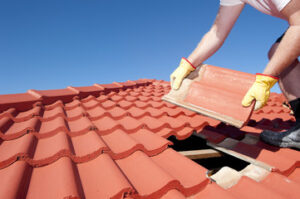Roofing Phoenixville PA is the outer layer of material that protects a house from rain, snow, sunlight and extreme temperatures. It can be constructed of a variety of materials. A person who specializes in roof construction is called a roofer.
Mineral wool insulation (R-4) is commonly used between the rafters and sheathing in residential construction. It is also sometimes placed between joists in wood-framed buildings.

The roof of a building is one of the most important components and contributes to its overall curb appeal. There are multiple roofing materials available on the market with varying lifespans and benefits. Each has its own unique qualities that can make it an ideal choice for your home. Talk to a roofing contractor to learn more about the options and to find out which type of material is best suited to your build.
Asphalt shingles are the most common roofing material and are available in several styles. 3-tab shingles are traditional and work well with most home styles, while dimensional and premium shingles offer more design options. Impact-rated shingles are also available to protect your roof from hail damage.
Slate is an attractive and durable roofing material that is often found on historical buildings and luxury homes. It’s a heavy and fire-resistant roofing material that can last for more than 100 years. It can withstand severe weather, including wind and rain, and is an excellent option for areas with wildfire hazards. However, slate is also very expensive and requires a lot of maintenance, such as frequent sealing and cleaning.
Tile is another beautiful and aesthetically pleasing roofing material that adds character to any home. These roofs are incredibly durable and resist high winds, earthquakes, salty air, and insect damage. They can also be very energy efficient, allowing you to save on your electricity bill. However, this type of roof is not suitable for every climate and may require extra insulation.
Plastic and bitumen roof sheets are a cost-effective alternative to shingle roofing materials. They are easy to install and work well for sheds, garages, and small builds. They are water-tight and can be covered in a variety of colors to match the style of your property.
Metal roofing is a great option for those who want a modern or industrial look to their building. These roofs can be fabricated to look like shingles or shakes and are long-lasting, with a life expectancy of 30-50 years.
If you’re looking for a roofing solution that can withstand harsh weather conditions, consider the thermoplastic polyolefin (TPO) or Polyvinyl Chloride (PVC) roof membranes. These durable roofs are puncture-resistant, able to stand up to chemical spills and oils, and can even combat bacterial growth and standing water. They’re also reflective and help to lower your energy costs by reducing the amount of heat that enters the building.
The roof of your home takes a beating from the elements. Wind, rain, hail, bitter cold, intense heat and strong sunlight all assault it regularly. That’s why your roof needs to be built and installed with materials that can withstand these insults.
You can install your own roof, or you can hire a professional. When you do hire a roofer, make sure the company has the proper licenses to work in your area, and check with your local building department and homeowners insurer for any special requirements they may have. Also, look for a roofer with many years in business, solid references and certification from the manufacturer of the roofing products you’re considering.
Before the shingles are installed, the contractor will lay down underlayment sheets to protect against water leaks. Then the shingle sheets are attached to the underlayment with a special roof cement, and nailing is done in a pattern that allows the shingles to overlap one another by about six inches. Nails are spaced about eight to 10 inches apart around the edge of the shingle and closer together in the middle.
Ventilation and insulation are other important aspects of a new roof. Your contractor will add a layer of insulation to help keep your house warmer in winter and cooler in summer, and they’ll seal all ventilation openings, such as those for sewer exhaust, ridge vents, attic fans and any other penetrations in the roof.
Roofing companies also often do work on chimneys and valleys, which are the V-shaped areas in the center of your roof where different parts of the roof meet. These are very prone to water damage, so these areas are coated with underlayment and felt paper to waterproof them. Then a protective coating is applied, such as tar or asphalt. If you’re interested in energy savings, ask your contractor if they have any reflective roof treatments. These keep heat from absorbing into a building, and they’re especially useful in warmer climates.
A thorough roof inspection is important throughout the year, but especially during times of extreme weather. This is an opportunity to catch small problems before they become big ones, like a missing shingle, and save thousands of dollars by fixing them before they do serious damage to the building or its contents. Inspections should include checking the shingles for excessive wear and tear, loose or damaged shingles and areas of decay under the shingles, as well as checking the caulking around chimneys, vent pipes and skylights to prevent leaks. It’s also a good idea to inspect for damage to the flashing (a thin metal material installed to prevent water leaks where the roof plane meets a vertical surface such as a chimney or dormer) and to look for areas of deterioration in the flashing.
Trimming large tree branches that overhang the roof, or that look like they might break off during a storm should also be done regularly. This protects the roof from falling debris and can help keep it safe during a heavy storm. Regular maintenance should also include cleaning the gutters and downspouts and ensuring that the soffit and fascia are in good condition. In some cases, a roof made from cut turf (modern ones known as green roofs, traditional ones as sod) may be recommended, as these provide effective insulating properties and help with the absorption of rainwater.
Roofing repairs are often made to replace or fix damaged materials like shingles, tar paper, and flashing. They may also address cracks and gaps, which can let in wind and water. Repairing these issues can help prevent leaks and improve the overall strength of a roof.
Unlike re-painting a room or staining the cabinets, repairing your roof can require quite an extensive amount of time and effort. It can also cost more than a full replacement, depending on the extent of the damage.
Most roofing repairs involve removing the old shingle and then applying another layer over it. This can be done for a large portion of the roof or just a few spots that are worn or damaged. The new shingles can be placed in the same pattern as the original ones, or a different style can be used.
Some common roofing repair tools include a pry bar for getting under the shingles, shears for neatly cutting shingles, and a set of roofing nails. Having the proper tools is essential to getting the job done right. It is recommended that you consult a professional before starting any roofing repairs. They can identify the problems and recommend the best course of action. They can also offer guidance in selecting the right materials for your roof. They will also have the necessary expertise to carry out the repair efficiently.


